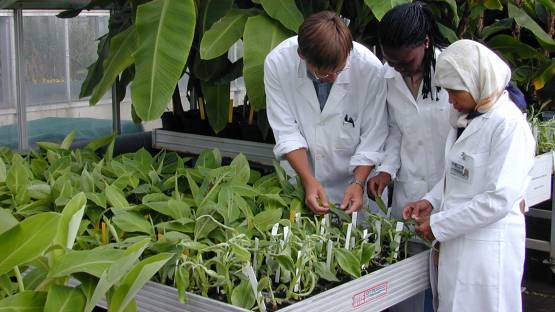Bananas are making headlines these days, as the world’s most widely cultivated variety – the Cavendish – is increasingly falling prey to a new strain of a deadly fungus, endangering its very existence. In a race against time, experts from nine institutes across the globe met at the IAEA in Vienna last week to step up research on plant breeding methods, including with the use of nuclear techniques, to develop plants that are resistant to this new strain of Banana Wilt, helping secure the livelihoods – and nutritional intake – of millions.
A new research project, supported by the IAEA in cooperation with the Food and Agriculture Organization of the United Nations (FAO), will focus on the development of technology to speed up the breeding of disease-resistant banana and coffee plant varieties.
“We are discussing how different countries can induce mutation in their banana plants and develop methods to screen for disease resistance very rapidly in laboratories, greenhouses and fields to find the rare mutation that will withstand the disease” said Bradley Till, plant geneticist at the Joint FAO/IAEA Division of Nuclear Techniques in Food and Agriculture, and research project leader.
As with any organisms, plants continually mutate over time to adapt to the environment and external stressors. This natural course, however, may take millions of years, and nuclear technology can be used very effectively to accelerate it. By exposing seeds, or plant tissue, to radiation such as gamma rays, scientists speed up the natural process of mutation, and breeders are able to develop new varieties. Further, molecular-marking techniques help researchers better manage the selection of plants with a higher number of desired traits, such as disease resistance, for further cultivation.
A recent Public Library of Science (PLOS) Pathogen study confirmed that one of the world’s top 10 food commodities, the sweet-tasting Cavendish banana commonly found in the supermarkets of Europe and North America, is seriously threatened by the new strain of the fungus that causes Banana Fusarium Wilt, Tropical Race 4. The soil-borne pathogen enters the plant’s roots and quickly spreads to its vascular system, causing the leaves to wilt and yellow, eventually killing it. An earlier strain of the fungus was responsible for the near extinction of the popular Gros Michel banana variety in the 1960s.
Originally limited to parts of Asia and Australia’s Northern Territories, Tropical Race 4 has since 2013 spread to Jordan, Lebanon and parts of Africa. The study points out that it is only a matter of time before the fungus reaches other areas, such as Latin America and the Caribbean, which account for the bulk of global banana exports.
Plant diseases are a major threat to food security, and global losses to pre-harvest blights are estimated at over 10 per cent. Historical examples, such as the great Irish famine in the 1840s, show that pests can strike quickly and decimate vulnerable crops within months, with devastating consequences to local populations.
Climate change, new strains of fungicide-resistant pathogens, such as Tropical Race 4, and a growing reliance on exclusive monocultures in the last half century to satisfy consumer preferences and transport requirements, are factors that leave plants even more vulnerable and increase the severity of the problem.
Genetic engineering is also an alternative to introduce disease-resistance into bananas like the Cavendish, which do not produce seeds and cannot be crossed, but public acceptance of genetically modified foods can be low, and so induced mutations provide a viable alternative, without introducing foreign genes. “It’s a cheap and easy way to introduce variation in the genome of the bananas to create new traits. It has been proven in hundreds of species,” Till said.
It is still difficult to predict when the current banana research will yield its first results, and the project’s primary goal at the moment is to build a network and critical mass of capacity to have tools in place countries can use to fight Tropical Race 4 and its possible variations. Till stresses that the technologies developed should be useful for a variety of pathogens and pathogenic races.
“This research project is very important. China has the same problem as other countries, and Panama disease has spread very quickly,” said Ganjun Yi, Vice President and Professor at the Guangdong Academy of Agricultural Sciences, a participating institution that has had some success in generating Tropical Race 4 resistance in Cavendish bananas using genetic engineering. “We are scientists from different countries; the aim is the same, but we use different ways to introduce mutants so we can collect all of our ideas and produce a better research result.”
The IAEA, in partnership with the FAO, has been assisting Member States in using radiation technology to create new varieties of plants for decades. Today, the Joint FAO/IAEA Mutant Variety Database counts over 3,200 improved plants, out of which 510 have been bred to be more resistant to stressors such as diseases and insect pests, and 330 specifically to resist fungal infections. In 2014, for example, a multinational effort debuted two successful new wheat varieties resistant to the Ug99 strain of the stem rust fungus, which have been since cultivated successfully in Kenya.


